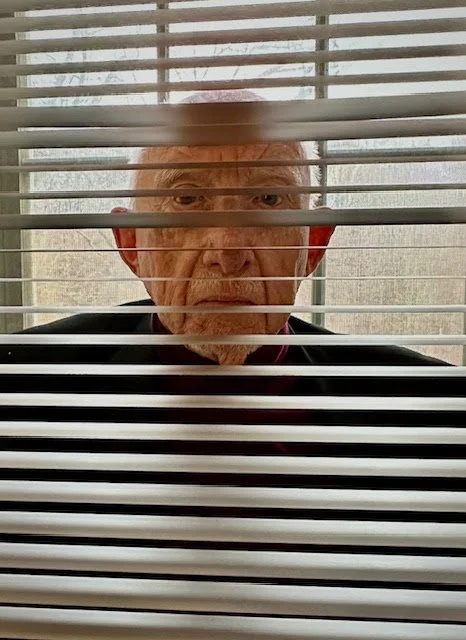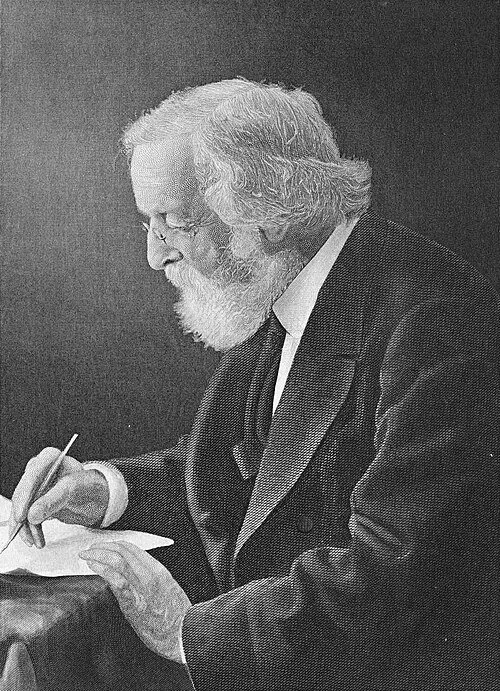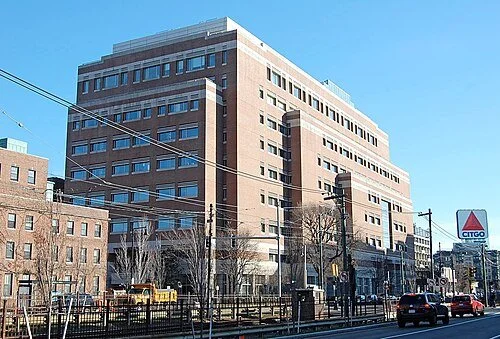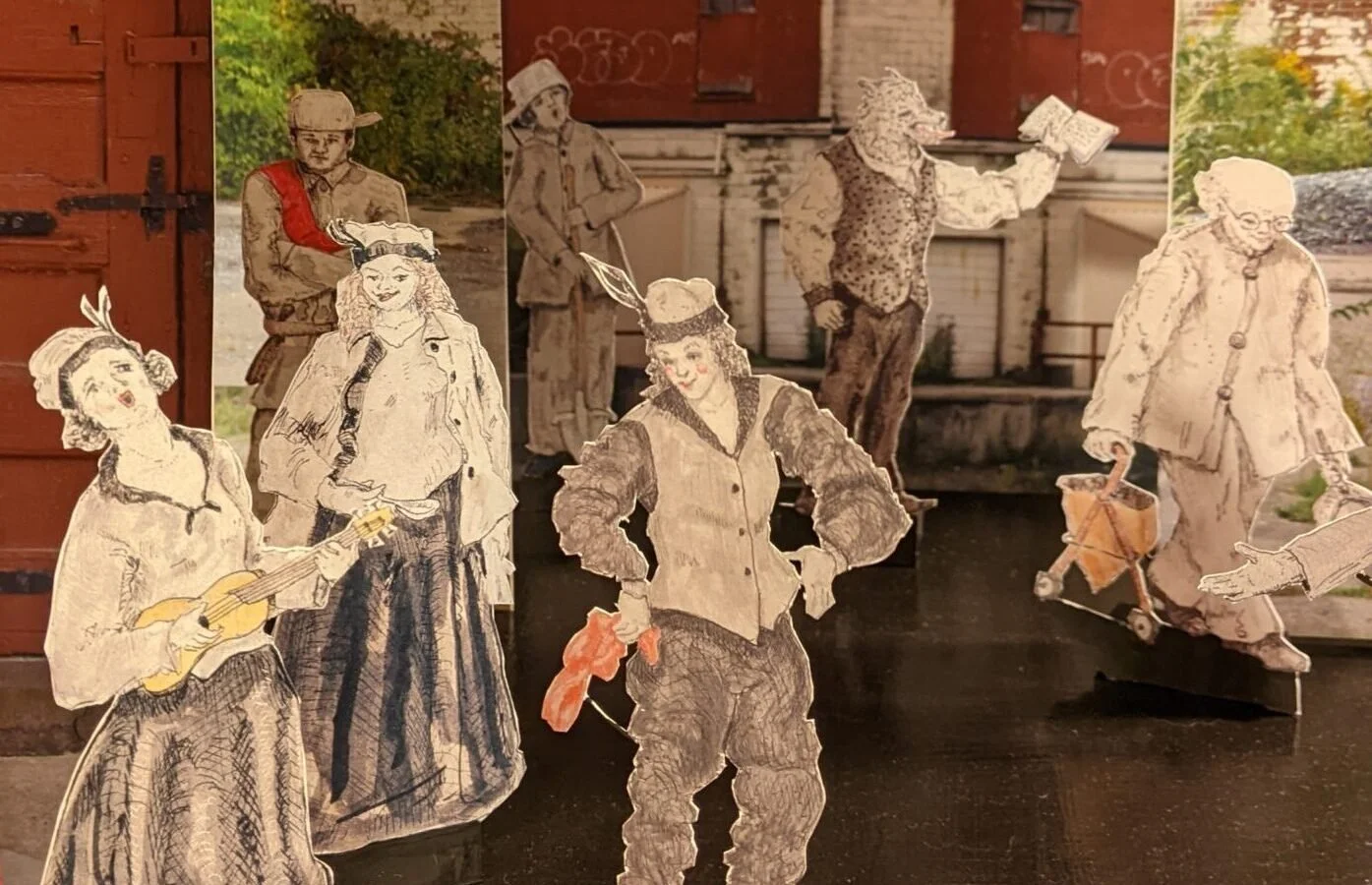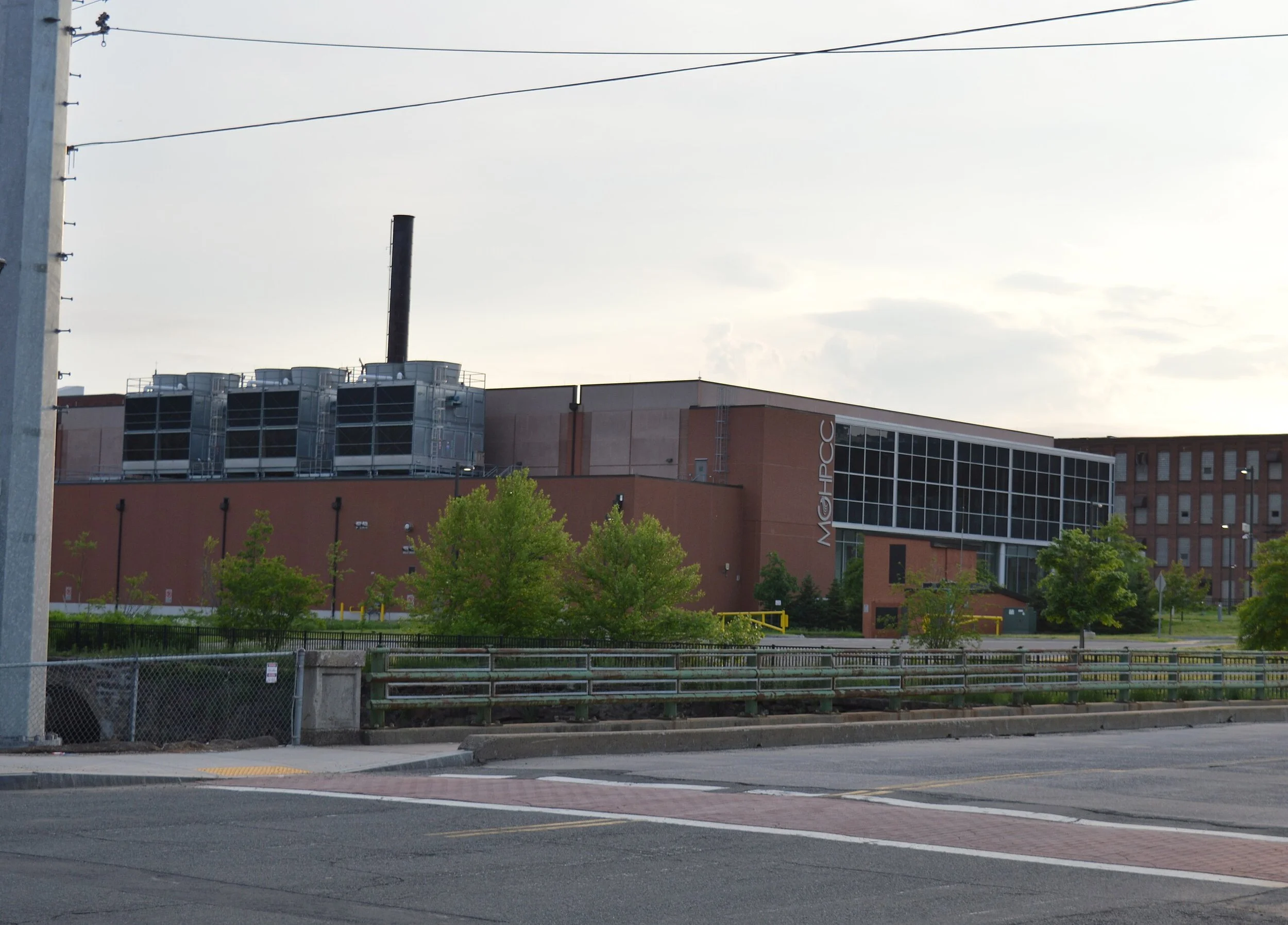
Emily Greene-Colozzi: There’s a lack of evidence that tech stops school shootings
Memorial flowers outside the Brown engineering complex, where the shootings happened.
Via The Conversation, except for the image above.
Emily Greene-Colozzi is an assistant professor of criminology and justice studies at the University of Massachusetts at Lowell. She receives funding from the National Institute of Justice.
A group of college students braved the frigid New England weather on Dec. 13, 2025, to attend a late- afternoon review session at Brown University, in Providence. Eleven of those students were struck by gunfire when a shooter entered the lecture hall. Two didn’t survive.
Shortly after, a petition circulated calling for better security for Brown students, including ID-card entry to campus buildings and improved surveillance cameras. As often happens in the aftermath of tragedy, the conversation turned to lessons for the future, especially in terms of school security.
There has been rapid growth of the nation’s now $4 billion school security industry. Schools have many options, from traditional metal detectors and cameras to gunshot detection systems and weaponized drones. There are also purveyors of artificial-intelligence-assisted surveillance systems that promise prevention: The gun will be detected before any shots are fired, and the shooting will never happen.
They appeal to institutions struggling to protect their communities, and are marketed aggressively as the future of school shooting prevention.
I’m a criminologist who studies mass shootings and school violence. In my research, I’ve found that there’s a lack of evidence to support the effectiveness of these technological interventions.
Grasping for a solution
Implementation has not lagged. A survey from Campus Safety Magazine found that about 24% of K-12 schools report video-assisted weapons detection systems, and 14% use gunshot detection systems, like ShotSpotter.
Gunshot detection uses acoustic sensors placed within an area to detect gunfire and alert police. Research has shown that gunshot detection may help police respond faster to gun crimes, but it has little to no role in preventing gun violence.
Still, schools may be warming to the idea of gunshot detection to address the threat of a campus shooter. In 2022, the school board in Manchester, N.H., voted to implement ShotSpotter in the district’s schools after a series of active-shooter threats.
Other companies claim their technologies provide real-time visual weapons detection. Evolv is an AI screening system for detecting concealed weapons, which has been implemented in more than 400 school buildings since 2021. ZeroEyes and Omnilert are AI-assisted security camera systems that detect firearms and promise to notify authorities within seconds or minutes of a gun being detected.
These systems analyze surveillance video with AI programs trained to recognize a range of visual cues, including different types of guns and behavioral indicators of aggression. Upon recognizing a threat, the system notifies a human verification team, which can then activate a prescribed response plan
.
But even these highly sophisticated systems can fail to detect a real threat, leading to questions about the utility of security technology. Antioch High School in Nashville, Tennessee, was equipped with Omnilert’s gun detection technology in January 2025 when a student walked inside the school building with a gun and shot several classmates, one fatally, before killing himself.
School security technology firm ZeroEyes uses this greenscreen lab to test and train artificial intelligence to spot visible guns. AP Photo/Matt Slocum
Lack of evidence
This demonstrates an enduring problem with the school security technology industry: Most of these technologies are untested, and their effect on safety is unproven. Even gunshot-detection systems have not been studied in the context of school and mass shootings outside of simulation studies. School shooting research has very little to offer in terms of assessing the value of these tools, because there are no studies out there.
This lack is partly due to the low incidence of mass and school shootings. Even with a broad definition of school shootings – any gunfire on school grounds resulting in injury – the annual rate across America is approximately 24 incidents per year. That’s 24 more than anyone would want, but it’s a small sample size for research. And there are few, if any, ethically and empirically sound ways to test whether a campus fortified with ShotSpotter or the newest AI surveillance cameras is less likely to experience an active shooter incident because the probability of that school being victimized is already so low.
Existing research provides a useful overview of the school safety technology landscape, but it offers little evidence of how well this technology actually prevents violence. The National Institute of Justice last published its Comprehensive Report on School Safety Technology in 2016, but its finding that the adoption of biometrics, “smart” cameras and weapons detection systems was outpacing research on the efficacy of the technology is still true today. The Rand Corporation and the University of Michigan Institute for Firearm Injury Prevention have produced similar findings that demonstrate limited or no evidence that these new technologies improve school safety and reduce risks.
While researchers can study some aspects of how the environment and security affect mass shooting outcomes, many of these technologies are too new to be included in studies, or too sparsely implemented to show any meaningful impact on outcomes.
My research on active and mass shootings has suggested that the security features with the most lifesaving potential are not part of highly technical systems: They are simple procedures such as lockdowns during shootings.
The tech keeps coming
Nevertheless, technological innovations continue to drive the school-safety industry. Campus Guardian Angel, launched out of Texas in 2023, promises a rapid drone response to an active school shooter. Founder Justin Marston compared the drone system to “having a SEAL team in the parking lot.” At $15,000 per box of six drones, and an additional monthly service charge per student, the drones are equipped with nonlethal weaponry, including flash-bangs and pepper spray guns.
In late 2025, three Florida school districts announced their participation in Campus Guardian Angel’s pilot programs.
Three school districts in Florida are part of a pilot program to test drones that respond to school shootings.
There is no shortage of proposed technologies. A presentation from the 2023 International Conference on Computer and Applications described a cutting-edge architectural design system that integrates artificial intelligence and biometrics to bolster school security. And yet, the language used to describe the outcomes of this system leaned away from prevention, instead offering to “mitigate the potential” for a mass shooting to be carried out effectively.
While the difference is subtle, prevention and mitigation reflect two different things. Prevention is stopping something avoidable. Mitigation is consequence management: reducing the harm of an unavoidable hazard.
Response versus prevention
This is another of the enduring limitations of most emerging technologies being advertised as mas-s shooting prevention: They don’t prevent shootings. They may streamline a response to a crisis and speed up the resolution of the incident. With most active shooter incidents lasting fewer than 10 minutes, time saved could have critical lifesaving implications.
But by the time ShotSpotter has detected gunshots on a college campus, or Campus Guardian Angel has been activated in the hallways of a high school, the window for preventing the shooting has long since passed.
‘How ideas reassemble’
“Fragments” (paper, steel, ceramic, thread), by Virginia Mahoney, at Kingston Gallery, Boston, Feb. 5-March 1.
The gallery says:
“Virginia Mahoney deepens her exploration of memory, materiality, and the personal archaeology of her creative life. This exhibition emerges from her long- term impulse to save parts of old work, remnants of past processes, and fragments that still hold potential meaning. The pieces in ‘Fragments’ extend her ongoing reflection on how ideas evolve, break apart, and reassemble over time.’’
Llewellyn King: Trump gave us a year of fear: And 2026?
WEST WARWICK, R.I.
Of all the things that happened in 2025 — a year dominated by the presidency of Donald Trump — not the least is that great fear came to America.
It's reminiscent of the fear that African-Americans knew in the days of the lynch mob, or that Jews have felt from time to time, or that Hollywood felt during the blacklist of the 1940s and 1950s, or the fear that people of Japanese descent from the West Coast, who were mostly U.S. citizens, felt when they were rounded up and interred following the attack on Pearl Harbor.
For some, it is a low-grade fear of reprisals, financial ruin and humiliation. And for some, it is a fear of ruin by litigation. But for others, it is fear of faceless arrest, the jail cell and plastic handcuffs.
All of this has made us a nation in fear and removed our faith in our laws, our Constitution, and our plain decency.
This is a new kind of fear that is acute in places, such as immigrant communities, but more universal than in the past.
It isn't the fear of a foreign power or an alien ideology or a disease, but a fear generated domestically — generated by our own government. Fear in our workplaces, our schools, our movie studios, our newsrooms and our universities.
For the first time, this year we saw troops on the streets of cities when there was no civil unrest — as there was, for example, during the riots of 1968, which followed the assassination of Martin Luther King Jr.
We saw troops deployed in cities where they weren't wanted, opposed by the local government and local people. But those cities got the troops courtesy of an assertion by the president that troops can manage law enforcement better than the local police. Or was there some more sinister purpose?
For the first time, we saw arrests without charge or evidence, carried out by masked ICE agents, of people simply suspected of being here illegally.
Often the suspicion is no more than the color of the arrestee's skin, their dress and their demeanor. No crime needs to be proved by this army of the state, dressed to intimidate. To the ICE men and women, appearance is tantamount to conviction.
Nightly on television we watched agents drag away men, women and children without due process; they would been held and deported without charge, trial or having any avenue of appeal. Justice denied, nonoperational. Often deportees go to countries that are alien or different from their homelands.
Fear has come home.
Immigrants are frightened even if they are citizens. If you have olive-toned skin, you can be dragged and held incommunicado. No appeal, no trial, no court appearance, no access to help. Habeas corpus suspended.
Pinch yourself and ask: Is this the America we cherish for its freedom, its justice and its generosity of spirit?
The fear isn't confined to those who might be swept up in the mindless cruelty of ICE but extends throughout society. People with stature fear that if they speak out, if they do what at other times they might have seen as their civic duty, they will endanger themselves and their families. All the government has to do is to start an investigation or threaten one and the damage is done, the first level of punishment is delivered.
Investigations can target anything from how you filled out a mortgage application to whether you wrote something that may be viewed as objectionable, and the punishment begins.
Fear stalks the schools where teachers and professors can be punished for what they say or teach, and where the institutions of higher learning are subject to political scrutiny. Politics has become the law, capricious and savage.
There is fear in business, where so many companies rely on government loan guarantees or tax credits for their growth. There is fear that if they say anything that can be construed as disloyal, they will be punished.
Political opponents fear that their mortgage applications may be deemed to be irregular and they are to be censured or prosecuted. Political prosecution is now a government tool.
Others just fear that Trump will ridicule them in public with his schoolyard denigrations, particularly members of Congress. They fear they will be reprimanded and marked for defeat in the polls.
There is an awful completeness about the Trump rampage: his systematic ignoring of norms, shredding of the rights of the individual, destroying families and bringing about untold misery.
A question for all America: How is the spreading of fear — sometimes an acute fear and sometimes low-grade fear — throughout society beneficial and to whom?
We, the people, deserve to know.
X: @llewellynking2
Llewellyn King is executive producer and host of White House Chronicle, on PBS, and an international energy-sector consultant. He’s based in Rhode Island.
Religion embraces science
“Einstein & the Jealous Monk (after Bob Dylan)” (acrylic on canvas), by English painter Chris Gollon (1953-2017), in the permanent collection of Huddersfield Art Gallery, alongside works by Francis Bacon, Walter Sickert and Henry Moore.
Gerald FitzGerald: My exotic adventures on a dairy farm
I stood on green mash loaded on the wagon floor next to a pony-tailed, skinny day laborer, both of us pitching the silage with big steel forks, until the pain blitzed through my right calf straight to my brain. Looking down, I saw two tines embedded in my leg. His hands were no longer holding his pitchfork but it stayed perpendicular to my leg, steady and straight as an erection. The kid looked stupefied; hands to his face, eyes glaring as if I were suddenly headless.
I cannot recall who pulled out the fork but I do remember thinking how often I’d used those forks to finish off a load of dry manure in the small dump truck for delivery to customers of the farm, in Concord, Mass. Holly and I had spent all our savings backpacking for two years pretty much ‘round the world and her Aunt Betty was kind to offer a minimum wage job on her dairy farm and use of the old trailer to live in back by the bullpen. The trailer kept us dry and the heating usually worked.
Then Holly had a brilliant idea: fresh paint the long side of the trailer, not so much with a color as with a vision. She’d loved our adventures in East Africa. So Holly invited family and friends to join us in creating a mural of savannah on the outside of the trailer to include acacia trees, monkeys, a rhino, water buffalo, giraffe and Holly’s lion.
Best of all, we had a real vegetable garden growing just outside our door so we needn’t pick its sweet corn until the water was boiling.
Farm life was good, with warm bread, bacon and black coffee to begin each workday morning at 6:15 in Betty’s kitchen. A herdsman milked twice daily, which was fine by me since cows take no holidays at all. I never counted the cows, but I want to say that there were at least 30 or so milkers in the barn, each one an Ayrshire. Ayrshires are Scottish with white and red to brown markings. They don’t give as much milk as, say, a Holstein, but they give more cream. I bedded each cow in its stall twice a day by scraping out and replacing the wet soiled wood shavings. Also, I checked each one’s steel bowl to keep it free of all but water made to flow by the bovine depressing a small circular float with its muzzle. I also added grain to a mix of hay and silage placed twice daily within easy eating range.
Gutters ran through the floor beneath the back ends of the stalls. They contained metal sweepers activated to push the waste along to a steel conveyor belt that carried it all up to the deep end of a dump truck. When the truck was full it was driven to a field and dumped out to dry. Some manure was loaded into a spreader for a springtime cover of the acreage. Depending on the need and the season I plowed fields, seeded crops, spread manure, baled hay and filled the lofts, patched barn roofs, stored new loads of shavings, turned the cows out to pasture to graze or called them home again, cleaned the milk pipes, mucked the stalls or delivered product to residential and commercial customers. Once I watched a dead cow being dragged out of the barn with a rope pulled by a tractor, I think to be chain-sawed to pieces for disposal. Twice, I watched the herdsman try to jump-start a pickup only to have the battery explode nearly in his face. Twice.
When calves were born, I taught them to drink from a bucket by submerging my hand in the formula and coaxing them to suck my two fingers like a teat. Female calves were eventually taken to the heifer barn; the young males were soon sold for veal. The farm only needed one bull, and I suspect that he was generally happy, though possibly less so when the eldest son used rubber-gloved hands to extract bull semen back in the day when A.I. meant artificial insemination.
One sunny autumn day I got to wade thigh-deep in fresh garbage at the Concord landfill. I collected trash weekly from the farm and its workers’ homes. Arriving at one house I found the plastic bags piled in the trash corner of the garage. Atop the bags lay a wreath made of brown growth and pine cones. Its presence gave me pause. I knocked on the side door loudly. Nobody was home. To me the wreath looked like something found in an Amish store in Ohio. And, to me, there it would stay.
But crafts are tricky; you know, “one man’s treasure, etc.” But here it lay squarely piled with the trash without a warning note or sign and nobody home in these days before cell phones. I carted it off with the rest. I was wrong. I received a message sternly summarizing the frantic concerns of the wife who’d made the object, along with a directive to return to the landfill to make close inspection until I found the wreath. It took a messy while but I did.
The farm had its own gasoline pump. Arguably, the stupidest act I ever committed on the farm was to leave my burning cigarette in the ashtray of a dump truck while I stepped out to fill its tank situated behind and below the driver’s door. I removed the cap from the short fuel filler neck, filled the tank, replaced the handle on the pump and climbed back inside. Then I saw my cigarette. With my right hand I took one last drag as I pulled away, while cranking down the window with my left. I tossed the lit butt out the window. A millisecond later, horror filled my head. I had not replaced the gas cap. I faced the side mirror in time to see the glowing tip of the cigarette wobbly balancing on the rim of the open fuel neck before falling… to the dirt. I leapt from the truck and crushed the butt with my foot, then walked the few steps back to the gas cap and replaced it. A few years earlier in Vietnam I had been struck by an artillery round that landed in my foxhole but failed to explode. Not a day has passed since without me seeing that shell, over and over again.
Not so often, but occasionally, I still see that glowing cigarette vertically wobbling on the rim of the fuel pipe.
I had never done well in school, but I stuck with it, mostly from Holly’s encouragement. So, after moving to the farm, I found a nearby state college and signed up for night classes. This was the sixth college I attended. At registration I waited in one long line and noticed a shorter one moving in a different direction. I eavesdropped on some chatting girls and discovered that they were in line to register for a path that provided college credit for “life experience” – if you could demonstrate valuable knowledge derived outside of the classroom. I switched to that line and was accepted. About 17 months after joining the farm I was but one course shy of a college degree and had scored successfully in taking the law boards.
At the farm, we sold manure both dried and wet. The wet was less expensive but more difficult to handle. I drove an order of three cubic yards, wet, over to a home in a particularly upscale neighborhood of Lexington, just a Minuteman’s march from Concord. It was a lovely stone-fronted home with a long driveway and curved flagstone walk to the front door, flanked by landscaped cedar gardens. A woman came out to greet me and even asked my name before giving directions as to how the load should be divided. I explained to her that the dump truck was not a precise machine, particularly when dropping a wet (i.e., almost liquid) load of fresh manure.
“Nothing drops until the truck bed reaches the tipping point,” I told her. “I’ll flip the lever immediately and hope that sends the bed back down in time but to tell you the truth, ma’am, once that load starts to slip its momentum has a mind of its own.”
“Well, you know me, Jerry, “ she replied, “I cannot bear a mess.” First, I did not know her. I’d never met her before. Second, she’s the one who ordered the cheap stuff. I kept my hand on the hoist-control lever of that truck and worked it hard at the first suggestion of load movement, but in the end nothing on God’s earth was going to keep that heavy slop from emancipation once it started to slide. She jumped away from the emptying dump and watched open-mouthed as the three cubic yards groaned to earth in one loud, filthy blast. It covered the width of the driveway, then the strip of lawn, then seeped down the flagstone path. She began to scream. I jumped back into the cab and swung the truck around while mumbling apologies.
Exiting the driveway, I glanced in the rearview and saw that she was still screaming while standing in the brown river holding her head with both hands.
The farm was where Williams Road met the Old Road to Nine Acre Corner, and its fields back then began at every point of that junction. Soon, I was awarded the job of stringing double strands of barbed wire to fence every field in sight. Why? Because the President of the United States was coming to Concord Bridge to celebrate the 200th anniversary of the battles that opened America’s War of Independence. Gerald Ford was to speak at the bridge on April 19, 1975. Exuberant town fathers expected so many visitors that they had extended the official overflow parking much of the way down Old Road to Nine Acre Corner, at least three miles, or more, distant from the bridge. The farmers doubted that visitors would stick to the macadam of that narrow road but, more likely, would drive onto the moist fields to park. The spring thaw then would guarantee that we’d be hitching a tractor to one mud-stuck vehicle after another. It took two full days working alone to stake and string the barbed wire.
Despite the thickest work gloves I could find, my hands and fingers bled like Padre Pio. April 19th came and went with not a single vehicle parking in the overflow area. It took me two more days to take down all the pickets and roll up all that wire.
After that, life moved smoothly until I woke up one morning to discover that I could breathe only if I lay in one position. Holly drove me to Emerson Hospital, a mile or so up the road, the same place I went following the pitchfork stabbing. Only now it wasn’t just a trip to the ER. I was admitted to 10 days of intensive care. Most of the first week was spent trying to identify what was trying to kill me. Dr. Henry Childs, M.D., a distinguished young physician from neighboring Stow, Mass., worked diligently to find the culprit: Farmers Lung Disease. The spores from mold that can grow in damp hay penetrate the lining of the lungs and seriously constrict breathing. I and others had been breaking down a giant round hay bale to horse bales in a mostly closed barn just a few days earlier, without face masks. The others did not become ill.
What I recall most from my last few days in ICU is the parade of students from Boston/Cambridge medical schools who traveled out to Concord to observe and to question the bearer of a somewhat rare disease.
I just read online that a patient’s average life span after suffering Farmers Lung is about eight years. Thus far, it’s been fifty for me.
Gerald FitzGerald is a former newspaper reporter, managing editor, assistant district attorney and trial lawyer.
But don’t get depressed
“Field at Dusk” (oil on canvas, circa 1900), by Bruce Crane, at the Westerly (R.I.) Museum of American Impressionism.
Chris Powell: Don’t ask state employees if Connecticut should raise taxes
Hedge-fund mogul Ray Dalio, one of several billionaires living in Greenwich, Conn., long a home for very rich people.
MANCHESTER, Conn.
According to state Sen. Jan Hochadel, D-Meriden, Connecticut shouldn’t be afraid of taxing the wealthy more.
In a newspaper essay the other week Hochadel cited a study done last year by something called A Better Connecticut Institute. The study, the senator wrote, contended that “income taxes play almost no role in where high-earning individuals choose to live," and that “when states raise taxes on top earners, the number of wealthy residents who actually leave is statistically insignificant," only around 2 percent.
“Wealthy people, like everyone else, care about more than their tax bill," Hochadel wrote -- they also care about schools, public services, public safety, economic opportunities, and such.
Well, of course. But no one says that the wealthy care only about taxes and not about those other things. They care about many things, including taxes. It is a matter of judgment and degree.
Besides, who exactly should be considered wealthy for tax purposes?
The senator writes of “millionaires," but when retirement savings are added, housing-price inflation has made millionaires of tens of thousands of Connecticut residents who are not close to being plutocrats but still pay a lot in taxes. Millionaires are not as rich as they used to be.
Maybe certain billionaires don’t care about Connecticut's income tax, but then why have so many state residents who are not billionaires been moving to Florida and other low-tax states as they near retirement and even before? Why are states that don't tax their residents as much as Connecticut does growing economically and in population even as Connecticut's economy is stagnant and its population might be decreasing if not for the illegal immigration state government encourages?
As Connecticut's illegal immigration from Central America and the Caribbean suggests, migration is not entirely a matter of warmer winters. Those illegal immigrants see more money for themselves where there are colder winters. Contrary to Hochadel's suggestion, money and people still tend to go where they are treated best.
Liberal Democratic state legislators such as Hochadel have two reasons for framing their desire to increase state government spending as a matter of raising taxes only on the wealthy.
First is that these legislators can’t make a good case for spending more on the merits of the spending itself, a case that would persuade the less than wealthy. For decades these legislators have been bleating about poverty in Connecticut and appropriating more to alleviate it without reducing poverty at all. Some state government policies plainly perpetuate poverty. No state government seeking to reduce poverty would subsidize childbearing outside marriage and run schools by social promotion as Connecticut does. But ministering to poverty and making it generational provides much political patronage for Democrats.
Second is that while state government still neglects much human need, liberal Democratic legislators, being the tools of the government-employee unions, don't dare to examine the mismanagement, waste, fraud, and general excess in government, where much money could be saved. Reports in this regard by news organizations and the state auditors almost always pass without comment from liberal Democratic legislators. Most look away even from federal prosecutions of corruption in state government.
Now that Connecticut has become a one-party state, Democrats have become the party of government for its own sake -- not the party of efficient and effective government. Hochadel's essay revealed her as an embodiment of this problem.
The organization whose study the senator cited in her essay, A Better Connecticut Institute, consists mainly of government employee unions, and Hochadel herself is an officer of the Connecticut chapter of the American Federation of Teachers.
That is, the institute represents mostly state and municipal government employees, who just happen to be the recipients of most state and municipal government tax revenue.
Just as you shouldn't ask the barber if you need a haircut, you shouldn't seek advice from government employee unions about whether taxes should be raised so more money can be spent on their members. Bettering Connecticut requires much more than making government employees happy.
Chris Powell has written about Connecticut government and politics for many years (CPowell@cox.net).
Small to show the big
“Small Catastrophe’’ (plate glass with vitreous enamels), by Eric Sealine, in his show “Drift and Flow: All the Time in the World,’’ at Boston Sculptors Gallery.
The gallery says that the show, from the artist's archive, is a series of “abstracted land, sea and skyscapes rendered on glass." Its ‘‘freestanding jewel-like pieces, while intimate in scale, mimic larger geologic, fluid, and erosional forces — from continental drifts, to cloud formations in the sky, to the patterns of sand on the shoreline.’’
Kate Petty: America is in a perilous reading recession, worsening our national attention-deficit disorder
Bates Hall in the Boston Public Library’s McKim Building.
—Photo by Brian Johnson
The United States is in the grip of a reading recession—nearly half of Americans didn’t read a single book in 2023, and fewer than half read even one, according to data from YouGov and the National Endowment for the Arts (NEA). Since the early 2000s, leisure reading has plunged by nearly 40 percent, a decline mirrored in falling reading scores and broader academic performance. What is at stake is not merely how people spend their free time, but a deeper erosion of the habits that sustain knowledge, empathy, and democratic life.
Decades of research show that the advantages of reading are both wide-ranging and profound. Regular engagement with books strengthens cognition, vocabulary, emotional intelligence, and empathy. These cognitive and social gains are closely linked to higher academic achievement, improved career prospects, greater economic stability, and increased civic engagement. Reading is one of the few activities that consistently bridges social divides—strengthening communities, encouraging civic participation, and sustaining democracy.
“The most important contribution of the invention of written language to the species is a democratic foundation for critical, inferential reasoning and reflective capacities,” writes cognitive neuroscientist and reading researcher Maryanne Wolf in her 2018 book Reader, Come Home. “If we in the 21st century are to preserve a vital collective conscience, we must ensure that all members of our society are able to read and think both deeply and well. … And we will fail as a society if we do not recognize and acknowledge the capacity for reflective reasoning in those who disagree with us.”
Literacy at Its Peak
Understanding the stakes of deep literacy today invites a look back at a time when reading was more than a pastime. More than a century ago, American writer and minister Gerald Stanley Lee captured reading’s transformative power in The Lost Art of Reading (1904): “The novel which gives itself to one to be breathed and lived… is the one which ‘gets a man somewhere’ most of all.”
Often described as America’s “golden age of reading,” the mid-20th century was a period when print media dominated daily life and literacy was widely cultivated across generations, supported by robust libraries, vibrant print journalism, and school curricula that treated reading as a central pillar of cultural participation.
According to NEA surveys, in the late 1940s, roughly 56–57 percent of adults read novels, short stories, poetry, or plays for pleasure. Daily newspaper readership was high, with about 65 percent of adults subscribing to or regularly reading newspapers, according to historical data from the Pew Research Center, while magazines such as Life, Time, and Reader’s Digest reached tens of millions of households.
Children and adolescents also read frequently outside of school, with 60–70 percent engaging in daily or near-daily reading, sustained by libraries, schools, and family practices, according to the National Literacy Trust. The period also saw the rise of shared reading experiences—fueled by organizations like the Book-of-the-Month Club and the Literary Guild—which broadened access to new titles, shaped national reading tastes, and helped make communal reading a mainstream cultural pastime.
The Data of Decline
By the early 2000s, national surveys were already signaling a decline in leisure reading in the United States. The NEA’s 2007 report “Reading at Risk: To Read or Not to Read: A Question of National Consequence” found that only 46.7 percent of adults read literature for pleasure, down from 54 percent a decade earlier.
Subsequent NEA surveys confirmed that the proportion of adults reading 12 or more books per year continued to fall. Gallup polls also reported a decline in the number of books read per year, from an average of 15.6 in 2016 to 12.6 in 2021. Time-use data from the American Academy of Arts & Sciences also shows that the share of Americans reading more than 20 minutes a day for personal interest dropped from 22.3 percent in 2003 to 14.6 percent in 2023.
Reading habits in the U.S. vary sharply by community type, income, and education. According to Pew (2021) and Library Research Service (2022), adults with higher education and income levels are far more likely to read regularly, while a 2011 Pew survey shows that rural residents lag behind urban and suburban peers, with fewer adults reporting reading for pleasure in the past year. Pew’s 2011 research found that 80 percent of urban and suburban adults read at least one book in the prior year, compared with 71 percent of rural adults, with significantly higher reading rates among college-educated and higher-income Americans than among less-educated and lower-income groups, revealing unequal cultural divides.
A landmark 2025 study published in iScience underscores the cultural shift reflected in declining reading habits. Tracking 236,270 individuals over two decades (2003–2023), the study examined both personal reading and reading with children and found that the share of U.S. adults reading for personal interest on an average day fell from roughly 28 percent in 2004 to 16 percent in 2023—a drop of about 12 percentage points.
“This is not just a small dip—it’s a sustained, steady decline of about 3 percent per year. It’s significant and it’s deeply concerning,” Jill Sonke, PhD, study co-author and director of research initiatives at the University of Florida Center for Arts in Medicine, said in a release about the study.
The research reveals a measurable, persistent, and accelerating trend in specific communities. In many of these households, children also have limited exposure to shared reading at home, further compounding early literacy gaps.
“Reading has always been one of the more accessible ways to support well-being,” said Daisy Fancourt, Ph.D., study co-author and professor of psychology and epidemiology at University College London. “To see this kind of decline is concerning because the research is clear: Reading is a vital health-enhancing behavior for every group within society, with benefits across the life-course.”
Lifelong Reading, Lifelong Benefits
Reading is a powerful tool for brain health, supporting cognitive function and emotional well-being throughout life. A 2009 study by the University of Sussex found that just six minutes of reading a day can reduce stress levels by up to 68 percent—more than listening to music or taking a walk—as well as lowering heart rate, reducing muscle tension, and improving sleep.
A 2020 study in International Psychogeriatrics found that consistent reading habits among older adults are associated with slower cognitive decline—independent of education and other risk factors. What’s more, a 2016 Social Science & Medicine study reported that book readers had roughly a 20 percent lower risk of death than non-readers.
As early as the mid-1940s, librarians and clinicians were documenting the use of reading as a therapeutic tool—a practice that came to be known as “bibliotherapy.” Case histories published in Library Journal, along with reports from psychiatric hospitals and educational settings, document how carefully chosen books could aid emotional healing, foster insight, and support rehabilitation.
Bibliotherapy is now practiced worldwide in public, academic, and hospital settings and is increasingly used by therapists as a mental-health support tool. As a 2025 BBC Future article notes, “Carefully selected books can provide emotional relief and help readers navigate difficult feelings, offering insights that might be hard to access otherwise.” An influential 2016 study published in Frontiers in Psychology found that engaging with literary fiction activates brain networks involved in social cognition, allowing readers to simulate other people’s thoughts and feelings, even when controlling for age, education, and IQ. “When readers engage with literary fiction, they actively simulate the experiences of others, enabling the use of social‑cognitive capacities in a way that non‑fiction simply does not,” the study notes. “If we become a nation of non-critical, superficial, shallow-skimming non-readers, we have no chance to build the base of empathy, critical analysis, and rigorous knowledge that is imperative for our next generation,” Reader, Come Home author Wolf said in an interview with the UCLA School of Education & Information.
The benefits begin early: A 2024 Psychological Medicine study of over 10,000 American children found that those who read early scored higher on cognitive tests and fared better emotionally as they entered adolescence. Yet many kids are missing out: A 2025 HarperCollins UK study reports that only 41 percent of kids ages 0–4 are read to regularly—a drop from 64 percent in 2012. The researchers note that Gen Z parents—many of whom grew up in the digital age—are more likely to see reading as academic rather than enjoyable. Nearly 30 percent say reading is “more a subject to learn than a fun thing to do,” compared with 21 percent of Gen X parents—and kids are following their lead: According to the study, 29 percent of children ages 5–13 now say reading feels like schoolwork, up from 25 percent in 2012.
“It’s very concerning that many children are growing up without a happy reading culture at home,” said Alison David, Consumer Insight Director at Farshore and HarperCollins Children’s Books, in a release about the study. “Children who are read to daily are almost three times as likely to choose to read independently compared to children who are only read to weekly at home.”
Early disparities in reading habits often persist into adulthood: American high school seniors are reading at lower levels than they have in over two decades, according to the 2024 National Assessment of Educational Progress (NAEP) report, which reveals a continuing long-term decline.
Low-Literacy, High Stakes
The stakes extend far beyond the classroom. Lesley Muldoon, executive director of the National Assessment Governing Board, warns, “These students are taking their next steps in life with fewer skills and less knowledge in core academics than their predecessors a decade ago, and this is happening at a time when rapid advancements in technology and society demand more of future workers and citizens, not less.”
Analysis from the 2023 Program for the International Assessment of Adult Competencies (PIAAC) reveals a “dwindling middle” in skill distribution, with more Americans clustering at the bottom levels of proficiency than in previous assessments. According to the study, the share of adults performing at the lowest literacy level rose from 19 percent in 2017 to 28 percent in 2023, and fewer than half of adults now reach the highest proficiency levels.
Low adult literacy is estimated to cost the U.S. economy $2.2 trillion annually, factoring in lost productivity, higher healthcare spending, and other social costs, according to a 2021 Adult Literacy and Learning Impact Network study, which reports that more than half of American adults read at Level 2 or below, and nearly 30 percent struggle with the most basic texts, limiting job opportunities and career growth.
The Rise of Digital Media
Such widespread literacy challenges don’t exist in a vacuum—they collide with a rapidly changing media environment that makes deep reading even harder to sustain. In today’s “attention economy,” digital platforms feast on Americans’ media appetite, serving a constant menu of bite-sized, algorithm-curated news and “infotainment” via phones, tablets, and streaming feeds. As more Americans turn to gig work and experience growing time scarcity, sustained reading is increasingly squeezed out by the low-effort pull of online streaming—according to Pew Research, roughly 83 percent of U.S. adults turn to online streaming, revealing how both shrinking leisure time and intense competition for attention are driving the decline.
Pew Research shows that 86 percent of Americans now get news digitally, while only 7 percent rely on print newspapers. According to Pew’s Social Media and News fact sheet, about 53–54 percent of U.S. adults report getting news from social platforms at least sometimes. Facebook (38 percent) and YouTube (35 percent) remain the leading news sources, followed by Instagram (20 percent), TikTok (17 percent), and X/Twitter (12 percent). Streaming has also become deeply embedded in American culture, with 83 percent of adults reporting use of streaming services.
Reading is no longer just a solitary pastime—it faces increased competition from online communities, social media, and other digital distractions. The mid-20th-century “middlebrow” culture, where book clubs, newspapers, and mass-market fiction created shared cultural touchstones, has largely faded. As Thomas Jefferson warned, “An informed citizenry is the only true repository of the public will,” and yet being “well-read” no longer carries the social prestige it once did; literacy and engagement with books are less visible markers of cultural participation, reducing the societal incentives to read deeply or widely. This dramatic migration to digital formats is not merely a change in medium—it is transforming the cognitive and social contexts in which information is interpreted. The combination of fast-paced digital formats, viral misinformation, and partisan echo chambers amplifies skepticism, making it harder for audiences to distinguish reliable reporting from opinion or disinformation.
A 2025 Gallup survey reveals that Americans’ confidence in mass media has plunged to a historic low—just 28 percent now say they have “a great deal” or “a fair amount” of trust in newspapers, TV, and radio to report news “fully, accurately and fairly.” The survey notes that when it began polling in the 1970s, trust ranged from 68 percent to 72 percent.
Screen-Inferiority Effect
The move from print to screens represents a fundamental change in how Americans encounter reading content, sharpening concerns about how people, especially students, process what they read—and where they read it.
A growing body of research suggests that reading on screens can undermine comprehension, attention, and deep engagement compared with print. This phenomenon, dubbed the “screen inferiority effect,” appears to stem from three key issues: cognitive overload (digital reading encourages multitasking and scrolling), a lack of spatial landmarks (print’s physical layout helps our brains remember where information is on the page), and the tendency to skim when reading online.
Young readers may be the hardest hit. Research suggests that children who grow up with paper books not only score better on reading assessments but may also achieve more academically—those with access to physical books reportedly complete an average of three more years of education. MRI studies show that these children develop stronger neural connections in brain regions responsible for language and self-control—connections that screen-heavy kids may lack.
Leisure reading on digital platforms has also been linked to lower comprehension among children and young adults, according to a 2023 Scholastica review, and other long-term studies suggest that print reading fosters stronger retention and deeper cognitive processing, as reported by The Guardian.
A 2025 study published in Frontiers of Psychology examined how different modes of reading—paper, digital, audio, and video—affect cognition and mental health of college students, finding that participants who read literary works in paper (or listened in audio formats) showed the greatest improvements, demonstrating better cognitive function and lower levels of anxiety and depression than those in digital, video, or control groups.
“Reading has declined because it’s facing growing competition from other forms of media consumption that may offer students more immediate gratification,” Martin West, professor of education at the Harvard Graduate School of Education and the deputy director of the Program on Education Policy and Governance at the Harvard Kennedy School, noted in a 2025 “Harvard Thinking” podcast.
“I think we have a lot of evidence to support the extent to which technology can be a distractor when students are engaged in learning processes. And that ability to distract, to compete for attention, could also lead to diminished appetite for persistence in reading on their own,” said West.
The Literacy Divide
The challenge isn’t just attention—it’s the unraveling of support systems that sustain reading in schools, including rising book prices, unequal access, and weakened infrastructure, all of which are eroding opportunities for leisure reading and amplifying the economic pressures behind the decline. According to the Center for American Progress 2024 report “Investing in School Libraries and Librarians to Improve Literacy Outcomes,” more than 50 years of research show that students with access to well‑resourced school libraries with certified librarians consistently perform better academically and score higher on standardized assessments.
However, America’s public schools have quietly but steadily shed thousands of certified school librarians. A national analysis from the School Librarian Investigation—Divergence & Evolution (SLIDE) Project found that librarian positions dropped by about 20 percent between 2009 and 2019, even as many districts increased spending on other staff roles.
The losses were not evenly shared: High-poverty districts, schools serving mostly Black, Hispanic, or multilingual students, and small rural systems were far more likely to lose their certified librarians entirely. Charter schools were hit hardest: Roughly 90 percent reported having no librarians at all. The strain on school libraries reflects a broader crisis in the U.S. public library system, where staffing shortages, budget pressures, and reduced services are also concentrated in high-poverty, high-minority, and rural districts. A study published as an EdWorkingPaper finds that between 2008 and 2019, 766 public library outlets closed, disproportionately affecting rural areas; the closures were associated with declines in nearby students’ reading and math test scores.
Tests Over Texts
Access to books shapes not only what students can read but also how reading is taught. A growing emphasis on standardized testing has increasingly displaced literature, narrowing curricula to measurable skills and focusing on short texts and assessment at the expense of sustained reading or literary exploration. “A critical part of becoming a literate person is to examine and explore a full text. This should be a major part of every student’s education,” writes Peter Greene in “The Atomization of Literature: How Standardized Testing Is Killing Reading Instruction,” published in Forbes.
“Instead of teaching students how to read a whole book, we teach them how to take a standardized test,” Greene argues, adding, “As long as high-stakes testing pushes a quick, superficial solo reaction to a context-free excerpt, schools will deprioritize teaching reading and literacy as a reflective, collaborative, thoughtful deep dive into a complete work. And that will be a loss for students.”
Rose Horowitch, in her 2024 Atlantic article “The Elite College Students Who Can’t Read Books,” cites a 2024 EducationWeek Research Center survey of about 300 third-to-eighth-grade educators, noting that only 17 percent said they primarily teach whole texts; an additional 49 percent combine whole texts with anthologies and excerpts. Horowitch emphasizes that nearly a quarter of respondents said that books are no longer the center of their curricula. “Whether through atrophy or apathy, a generation of students is reading fewer books,” writes Horowitch. “Students see reading books as akin to listening to vinyl records—something that a small subculture may still enjoy, but that’s mostly a relic of an earlier time.”
Counter-Currents: Signs of Hope
From smartphones to e-readers, new technology is beginning to erode the long-standing resilience of the paper book. About 30 percent of U.S. adults now read books digitally, according to the Pew Research Center. Audiobooks are experiencing even faster adoption: The Audio Publishers Association 2025 Consumer Survey found 51 percent of Americans aged 18 and older—an estimated 134 million people—have listened to an audiobook.
That momentum is matched—and in some ways surpassed—by the popularity of podcasts. Podcasting is booming in the U.S., reaching 210 million Americans and drawing 115 million weekly listeners as of 2025, according to Edison Research. Podcasting now accounts for roughly 11 percent of daily audio consumption, and over 1.1 million English-language podcast episodes have been identified via public RSS feeds.
One bright spot is that independent bookstores are experiencing a resurgence, often supported by local communities and curated events, and subscription book boxes make discovering new titles easier than ever. Social media, particularly TikTok’s “BookTok,” has become a powerful driver of reading among Gen Z, propelling interest in specific genres and bestselling titles. The growth of book‑subscription services suggests a counter-current supporting reading: the global market, valued at about $1.34 billion in 2024, is projected to nearly double by 2033, as more consumers seek curated deliveries to keep reading habits alive
The Path Ahead
To reverse the reading recession in the United States, experts say efforts need to reach across schools, families, and communities. “It will take a comprehensive ecosystem to support our students at every touchpoint,” says Dr. Paige Pullen, chief academic officer and literacy principal at the University of Florida’s Lastinger Center for Learning, in a releaseabout the innovative New Worlds Reading Initiative.
Created by the Florida Legislature in 2021, the program illustrates how multi-level, coordinated approaches can address declining reading rates. Offering modular training for educators from birth through 12th grade, incorporating evidence-based strategies, practical classroom applications, and ongoing mentorship, the initiative aims to support teachers in applying literacy practices in the classroom while promoting collaboration across schools and communities, helping ensure students receive consistent guidance in developing reading skills at each stage of learning.
Across the United States, several states are implementing ambitious literacy initiatives to address persistent reading gaps. Iowa, Arizona, Nebraska, Rhode Island, and Alaska have all received multi-million-dollar federal Comprehensive Literacy State Development (CLSD) grants to support evidence-based reading instruction, high-dose tutoring, and professional development for educators, with a focus on children in high-need communities. A range of literacy nonprofits and school programs are also stepping in to bolster reading skills and access to books, particularly for children in under-resourced communities.
The NEA offers a range of solutions to promote early reading at home—from in-clinic programs to digital tools and grassroots book-sharing initiatives. Nonprofits Reading Is Fundamental (RIF) and the Children’s Literacy Initiative are expanding access to books, supporting teachers, and strengthening reading instruction where schools need it most.
Raising a Reader partners with schools, community centers, and libraries to provide curated, multicultural book collections and training for parents. Reach Out and Read integrates literacy into pediatric care, giving books to young children during well-child visits and coaching caregivers on reading aloud together.
Worldreader—a global nonprofit that promotes family reading through its free digital app, BookSmart—is helping parents read to their children daily, even in low-resource settings.
Grants, policy incentives, and strategic partnerships are also critical to ensuring these efforts are sustainable and equitable. A policy brief from the Center for American Progress, “Investing in School Libraries and Librarians to Improve Literacy Outcomes,” argues that investing in certified school librarians, up-to-date collections, and teacher collaboration is a powerful lever to boost student literacy and long-term reading engagement.
Emerging technologies, such as augmented reality (AR technology) storybooks (Metabook) and interactive voice-assisted reading (TaleMate), combine engagement with learning, demonstrating how digital and print strategies can work together to foster reading habits, improve literacy outcomes, and transform libraries into immersive learning hubs.
Programs like Open eBooks—a collaboration among major publishers, libraries, and nonprofits—provide free access to thousands of eBooks for children in under-resourced communities. Penguin Random House’s Living Stories app merges read-aloud sessions with interactive lights and sounds to engage young readers. Library software providers like BiblioCommons integrate e-books into public library catalogs. At the same time, platforms such as Reading Plus and collaborations like Reading Partners + AT&T deliver personalized, digital literacy instruction to students at school and home.
Reversing America’s reading decline requires more than urging kids to pick up a book—it demands rebuilding a culture that champions literacy at every stage of life. This means addressing funding and staffing crises in school and public libraries, rethinking teaching practices that undervalue deep reading, and supporting parents in fostering early literacy. It also calls on policymakers, educators, and communities to invest in the long-term infrastructure that literacy requires.
The stakes are high: without intervention, the next generation risks inheriting a world of perpetual scrolling, fragmented attention, and shallow engagement with ideas. But with coordinated action, we can envision a future where books, both print and digital, reclaim their role as catalysts for curiosity, empathy, and civic understanding. Reading can once again be a shared cultural experience, a personal joy, and a cornerstone of an informed, connected society.
Kate Petty is an educator, writer, and environmental activist. She has worked with the New York Nature Conservancy and various United Nations initiatives, including UNICEF, the World Association of Non-Governmental Organizations, and the Universal Versatile Society to promote education, social justice, and solution-oriented projects for a healthier planet. She is a contributor to the Observatory.
This article was produced for the Observatory by the Independent Media Institute. It is licensed under the Creative Commons Attribution-NonCommercial-ShareAlike 4.0 International License (CC BY-NC-SA 4.0)
Why she lives there
Janet McTeer
— Photo by Siebbi
Lookout Point in Harpswell, Maine
“There's a reason I live in the Maine Woods, where nobody knows what I do for a living. I think you can be better if someone who's coming to see you perform has no idea who you really are.”
—Janet McTeer (born 1961) English actress. She’s been married to poet and fashion consultant Joseph Coleman since 2010. Mr. Coleman is also a registered Maine Guide.
When not in New York or elsewhere, Ms. McTeer lives in Harpswell, Maine, not exactly the “Maine Woods,’’ but rather a spiffy place on the coast with plenty of affluent summer people and folks linked to nearby Bowdoin College, in Brunswick. The Maine Coast has long drawn celebrities and rich people. The number has recently been rapidly increasing.
Statesmen are heavily outnumbered
James Freeman Clarke
“A politician thinks of the next election; a statesman of the next generation.’’
— James Freeman Clarke (181-1888), New England clergyman, theologian and author
At least no mosquitoes
“Morning Ice in December” (oil on canvas), by the late Severin Haines, from Collection of William and Dedee Shattuck, in show “Artistic Luminaries: Three Local Icons,’’ through Feb. 23 at the New Bedford Art Museum.
The museum explains:
{The} show celebrates “the careers of three friends and New Bedford art mainstays, Willoughby ‘Bill’ Elliott, Severin ‘Sig’ Haines and Marc St. Pierre. The three were “leading figures in the studios and classrooms of the Swain School of Design and the University of Massachusetts Dartmouth," and “their collective influence established a model of artistic and educational excellence that continues through successive generations of artists, remaining central to the South Coast’s creative identity.’’
Shark attack at B.U.
Outside B.U.’s Questroom School of Business, where the new SharkNinja lab will be housed.
Edited from a New England Council report.
“Boston University is partnering with SharkNinja to launch the SharkNinja AI & Analytics Lab, with the aim of merging academic insight with real-world business challenges for B.U. graduate students.
“The lab will be housed within Questroom’s Consulting Lab, where graduate students will work under faculty to design AI-driven solutions. Students will operate as a consulting team, using data-modeling techniques to support both hands-on product innovation and internal operations.
“‘We are here to help pore through large data sets to find those pockets of opportunity,’ said Peter Howard, executive director of Action Learning and the Questroom Consulting Lab.
‘“We’ll take on any type of challenge,’ he said. This initiative will give students the chance to apply their technical skills to high-impact projects while gaining direct decision-making experience.’’
Dramatic license
Detail from “Puppet Master,’’ by B. Lynch, in her show “Little Dramas,’’ at the Danforth Museum of Art, Framingham, Mass., through Jan. 11.
The museum says:
“Lynch has been working on this series for 13 years, and throughout, current events have shaped the way her creations develop and relate to one another. Her figures are darkly humorous, and slightly disarming, as using puppets to tell a story creates detachment in the viewer. The Reds exist in a fixed space, while her Grays hover in a somewhat vague past or future dystopia. These puppets are not meant to look realistic, they are playful and often a bit ridiculous; consequently, they ease the delivery of a difficult yet urgent contemporary message.’’
Michi Trota: The public pays a pile for Big Tech’s data centers
Servistar’s proposed huge data center in Westfield, Mass. It would require massive amounts of electricity.
The Massachusetts Green High Performance Computing Center, in Holyoke, a collaboration between several universities and corporate sponsors. including the University of Massachusetts, MIT, Harvard, Boston University, and Northeastern, and Dell ENC as well as Cisco.
Via OtherWords.org
Bill Gates recently made headlines by suggesting that climate change is no longer a priority, but the American public begs to differ.
In this last election, climate change was a defining issue in such states as Virginia and Georgia, where voters grappled with rising energy costs. And no matter how much tech billionaires try to distract us, increasing power costs and our worsening climate are directly connected to such corporations as Google, Meta, Microsoft, and Amazon racing to dominate the AI landscape.
According to the U.S. Energy Information Administration, the price of energy has risen at more than twice the rate of inflation since 2020, and Big Tech’s push for more power-hungry data centers is only making it worse.
The data centers proliferating across the country drive up energy costs by powering energy-ravenous generative AI, cloud storage, digital networks, and other energy intensive programs — much of it fueled by coal and natural gas that exacerbate climate change.
In some cases, data centers consume enough electricity to power the equivalent of a small city. The wholesale price of electricity in areas housing data centers is up a whopping 267 percent from five years ago — and everyday customers are eating those costs.
Americans are also shouldering increasing costs of an extreme climate.
The Joint Center for Housing Studies at Harvard noted that insurance prices rose 74 percent between 2008 and 2024 — and between 2018 and 2023, nearly 2 million people had their policies canceled by insurers because of climate risks.
Meanwhile, home prices have gone up 40 percent in the past two decades — meaning that the cost of home repair and recovery from climate disasters has also grown, all while wages remain stagnant.
Data centers aren’t just putting our wallets at risk. Power grids across the country are already strained from aging infrastructure and repeated battering during extreme weather events.
The additional pressure to feed energy-intensive data centers only heightens the risk of power blackouts in such emergencies as wildfires, deep freezes, and hurricanes. And in some communities, people’s taps have literally run dry because data centers used all the local groundwater.
Worse still, Big Tech’s AI energy demand has triggered a resurgence in dirty energy with the construction of new gas-powered energy plants and delayed shutdowns of fossil fuel-powered plants. The tech industry is even pushing for a revitalization of nuclear energy, including the planned 2028 reopening of Three Mile Island — site of the worst nuclear power plant disaster in U.S. history — to help power Microsoft’s data centers.
Everyday people bear the costs of Big Tech’s hunger for profits. We pay it in rising energy bills, our worsening climate, our lack of access to safe water, increased noise pollution, and risks to our health and safety.
It doesn’t have to be this way. Instead of raising our bills, draining our local resources, and destabilizing our climate, Big Tech could create more energy jobs, lessen our power bills, and sustain communities.
We can demand that tech giants such as Microsoft, Meta, Google, and Amazon uphold their commitments to use 100 percent renewable energy and not rely on fossil fuels and nuclear energy to power data centers.
We can insist that data centers only go where they’re wanted by ensuring communities are given full transparency and protection in how they’re affected by power usage, water access, and noise pollution.
The current administration is ignoring its obligations to the American public by refusing to rein in Big Tech. But tech billionaires still have a responsibility to the very public they depend on for their existence.
Michi Trota is the executive editor of Green America.
Those imaginative maps
Norman B. Leventhal Map & Education Center Collection / Boston and New England Maps / Mapping Boston Collection
The center explains (we have edited slightly):
“This map is the firsy printed version of William Reed's original survey of 1665. The survey was commissioned by Massachusetts authorities to support the colonial boundaries as described in the first Massachusetts Charter of 1628. As originally proposed, the northern boundary was 30 miles north of the Merrimack River, assuming that the river followed an east-west course.
When it was later discovered that inland the Merrimack River turned north, Massachusetts colonists aggressively claimed lands 30 miles north of the river's source, an area also claimed by New Hampshire. The survey is the earliest to depict the relative position of the Hudson, Connecticut and Merrimack rivers. Also identified on the map are several towns that had been destroyed by Indians during the early months of King Philip's War.
Creator:




